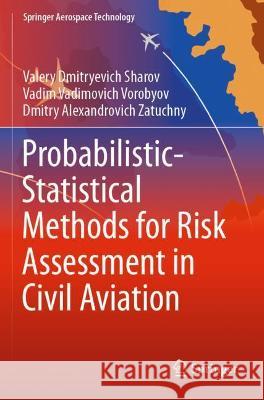Probabilistic-Statistical Methods for Risk Assessment in Civil Aviation » książka



Probabilistic-Statistical Methods for Risk Assessment in Civil Aviation
ISBN-13: 9789811600944 / Angielski / Miękka / 2022 / 176 str.
Probabilistic-Statistical Methods for Risk Assessment in Civil Aviation
ISBN-13: 9789811600944 / Angielski / Miękka / 2022 / 176 str.
(netto: 421,70 VAT: 5%)
Najniższa cena z 30 dni: 424,07
ok. 22 dni roboczych.
Darmowa dostawa!
Preface.
Chapter 1. Concept of risk and safety. Analysis of aviation safety regulations
1.1. Flight safety in the context of national safety policy. 1.2. Comparative estimation of flight safety situation in the Russian Federation and in the world. 1.2.1. Comparison of flight safety level in the Russian Federation and in the USA.1.2.2. Comparison of flight safety situation in the Russian Federation and in the member states of the ICAO.
1.3. Analysis of national and international regulations requirements to the flight operations safety management systems.
1.3.1 ICAO, IATA, and EASA standards and recommended practices.
1.3.2. Standards, regulations, and guidances of several states.1.4. Description of the current situation in the national flight safety program and in the flight operations safety management system of the Russian Federation.
1.5.Safety risk and its acceptable level.
1.5.1. Analysis of different approaches to risk definition.
1.5.2. Application of fuzzy sets and “soft estimation”.
1.5.3. Concept of acceptable risk.
Chapter 2. Analysis of navigational and meteorological risks that impact civil aviation flight safety.
2.1. Classification of emergency, critical, and failure situations in aviation enterprise.
2.2. Analysis of possible unauthorised actions on the navigation system of civil aviation aircraft.
2.2.1. Classification of possible radio electronic attacks on the navigation system of civil aviation aircraft.
2.2.2. Possibility of intentional interference for the purpose of the total or fragmentary destruction of navigation information.
2.2.3. Energy analysis of intentional interference possibility in GPS and GLONASS.
2.2.4. System vulnerability analysis for navigation systems of civil aviation aircraft.
2.3. Analysis of meteorological risks in aviation enterprise operation.
2.3.1. Air temperature.
2.3.2. Air humidity.
2.3.3. Atmosphere pressure.
2.3.4. Wind.
2.3.5. Windshifts.
2.3.6. Air turbulence.
2.3.7. Clouded sky and limited visibility.
2.3.8. Weather minimums.
2.3.9. Visibility range.
2.3.10. Aircraft icing.
2.3.11. Glazed frost and ice-covered ground.
2.3.12. Thunderstorms, squals, whirlwind, rain showers, hail.
Chapter 3. Risk assessment methods for aviation enterprise
3.1. Flight safety risk management in aviation enterprise as a task of situational management.
3.2. Studyof the known risk assessment methods applicability to aviation industry.
3.2.1. Classification of general risk assessment methods. Applicability analysis for qualitative and combined methods.
3.2.2. Applicability analysis for quantitative risk assessment methods .
3.2.3. Limitations of ICAO recommended conceptual risk assesment model.
3.2.4.Review of triple-component models for flight safety risk management.
3.3. Estimation of the flight risk in terms of technocratic conception .
3.3.1. Model of damage distribution for different flight scenarios .
3.3.2. Vulnerability for safety concerns as an important aviation enterprise characteristic.
3.4. Structure and principles of flight safety risk management system design in the aviation enterprise.
3.4.1. Mathematical description of flight safety risk management process.
3.4.2. Estimation of flight safety risk acceptability on the level of aviation enterprise.
3.4.3. Prognosticating of management decisions efficiency.
3.4.4. General principles of flight safety risk management system design in the aviation enterprise according to the proposed methodology.
Chapter 4. Definition and monitoring of flight safety performance factors.
4.1. Flight safety performance factors as criteria of flight safety risk management efficiency. Review of flight safety performance factors applicable in civil aviation.
4.2. Analysis of problematic issues in definition and application of flight safety statistical indicators.
4.3. Method of definition and monitoring of the state flight safety performance factor.
4.4. Methods of the conventional flight safety performance factors calculation and monitoring in the aviation enterprise.
4.4.1. Calculation of the factors according to ICAO recommendations.
4.4.2. Monitoring of conventional flight safety performance factors.
4.5. Methods of the new flight safety performance factors calculation and monitoring in the aviation enterprise.
4.5.1. Rationale for two criteria of flight safety assessment. Monitoring of the risk factor “risk ratio for defections and events” by method of cumulative amounts.
4.5.2. Method for decision-making support based on the factor analysis of the new flight safety indicators.
Appendix 1. Implementation of the program “Managerial decisions efficiency estimation”
Abbreviations
References
Valery Dmitryevich Sharov is Doctor of technical science, currently Professor of the Department of Flight and Life Safety at the Moscow State Technical University of Civil Aviation. He is the author of more than 100 scientific works on air navigation and flight safety, including 2 monographs. His research interests are in the area of flight safety management systems.
Vadim Vadimovich Vorobyov is Professor, Doctor of technical science, currently the Head of the Department of Flight and Life Safety at the Moscow State Technical University of Civil Aviation. His research interests are in the area of improvement of flight safety management systems.
This book analyses the models for major risks related to flight safety in the aviation sector and presents risk estimation methods through examples of several known aviation enterprises. The book provides a comprehensive content for professionals engaged in the development of flight safety regulatory framework as well as in the design and operation of ground-based or on-board flight support radio electronic systems. The book is also useful for senior students and postgraduates in aviation specialties, especially those related to air traffic management.
1997-2026 DolnySlask.com Agencja Internetowa
KrainaKsiazek.PL - Księgarnia Internetowa









